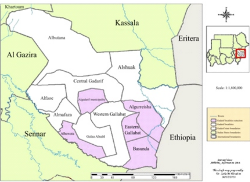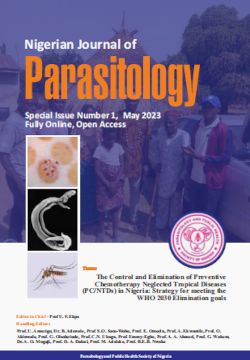Prevalence and Associated Risk Factors of <i>Leishmania</i> infection in Dogs in Al Gadarif State, Sudan: A Cross-Sectional Study
DOI:
https://doi.org/10.4314/njpar.v45i2.1Keywords:
Leishmaniasis, Sudan, Dogs, Prevalence, Risk FactorsAbstract
Human visceral leishmaniasis (VL) is an endemic disease in eastern Sudan, particularly in Al Gadarif State, causing significant morbidity and fatality rates. This disease is induced by Leishmania donovani and Leishmania infantum. Several studies have suggested that dogs (Canis familiaris), which are known for being the primary reservoir hosts of L. infantum (causing canine leishmaniasis), may play a vital role in transmitting human VL caused by L. donovani. This study aimed to determine the prevalence of leishmaniasis in general and L. donovani, particularly in dogs, and to investigate the potential risk factors associated with the disease in Al Gadarif State. Blood samples were collected from 151 dogs from five localities and examined using Giemsa-stained blood smears and PCR. The overall prevalence was 44.4% based on microscopic examination. Significant variation in the prevalence of leishmaniasis was observed among the localities (p = 0.000), where the highest prevalence was reported in Algurreisha (85%) and the lowest was observed in Alhawata (4.2%). Dog type was another risk factor that was shown to be significantly associated with infection (p = 0.041). The highest prevalence was reported in household dogs (47.7%) compared to stray dogs (23.8%). The analysis revealed that factors such as the use of dogs, sex, and age
were not statistically linked to the disease. However, among household dogs, the highest prevalence was reported in pet dogs (59.7%), males (49.1%) compared to females (32.6%), and young dogs (50%) compared to older dogs (40.9%). All blood samples tested negative for L. donovani by PCR, thus requiring further investigation to identify the causative species in dogs and their possible roles in the
epidemiology of zoonotic leishmaniasis in Sudan.
References
Office International des Epizooties (2023). Leishmaniosis. In: Manual of Diagnostic Tests and vaccines for Terrestrial Animals. Office International des Epizootic, Paris, France. https://www.woah.org/en/what-we-do/standards/codes-and-manuals/terrestrial-manual-online-access/ (accessed 10 November 2023)
Sharma, U., & Singh, S. (2008). Insect vectors of Leishmania: distribution, physiology and their control. Journal of Vector Borne Diseases, 45(4):255-272.
Pavli, A., & Maltezou, H. C. (2010). Leishmaniasis, an emerging infection in travelers. International Journal of Infectious Diseases, 14(12): e1032-e1039. doi:10.1016/j.ijid. 2010.06.019.
Pace, D.(2014). Leishmaniasis. The Journal of Infection, 69(1): 10-18. doi:10.1016/j.jinf.2014.07.016.
Torres-Guerrero, E., Quintanilla-Cedillo, M. R., Ruiz-Esmenjaud, J., & Arenas, R. (2017). Leishmaniasis: a review. F1000 Research, 6:750. doi:10.12688/ f1000 research.11120.1. 261 Nigerian Journal of Parasitology
Cardoso, L., Schallig, H., Persichetti, M. F., & Pennisi, M. G. (2021). New epidemiological aspects of animal leishmaniosis in Europe: The role of vertebrate hosts other than dogs. Pathogens (Basel, Switzerland), 10(3): 307. doi:10.3390/pathogens10030307.
Karimi, A., Alborzi, A., & Amanati, A. (2016). Visceral leishmaniasis: an update and literature review. Archives of Pediatric Infectious Diseases, 4(3): e31612. doi:10.5812/pedinfect.31612.
Moreno, J. & Alvar, J. (2002). Canine leishmaniasis: epidemiological risk and the experimental model. Trends in Parasitology, 18(9):399-405. Doi:10.1016/S1471-4922(02)02347-4.
Heidarpour, M., Pourtaghi, M., & Khoshnegah, J.(2012). Prevalence and risk factors for canine leishmaniasis in Mashhad, Northeast of Iran. Iranian Journal of Veterinary Science and Technology, 4(1): 37-46. doi:10.22067/VETERINARY.V4I1.17891.
Oliveira, A. M., Guirado, M. M., Dibo, M. R., Rodas, L. A., Bocchi, M. R., & Chiaravalloti-Neto. F. (2016). Occurrence of Lutzomyia longipalpis and human and canine cases of visceral leishmaniasis and evaluation of their expansion in the Northwest region of the State of São Paulo, Brazil. Revista da Sociedade Brasileira de Medicina Tropical, 49(1):41-50. doi:10.1590/0037-8682-0353-2015.
Boussaa, S., Kasbari, M., El Mzabi, A., & Boumezzough, A. (2014). Epidemiological investigation of canine leishmaniasis in southern Morocco. Advances in Epidemiology, 2014:1-8. doi:10.1155/2014/104697.
de Melo, M. A., Silva, R. B. S., e Silva, L. F. F., de Almeida Braz, B. M., dos Santos, J. M., Santos, S. J. S., & de Andrade, P. P. (2016). Canine visceral leishmaniasis in Brazil. In Kaoud, H.A.E. (eds). Canine Medicine - Recent Topics and Advanced Research. Intech Open, pp. 19-54. https://doi.org/10.5772/65956 (accessed 12 October 2023).
Reis, A. B., Martins-Filho, O. A., Teixeira-Carvalho, A., Carvalho, M. G., Mayrink, W., França-Silva, J. C.,Giunchetti, R. C., Genaro, O., & Corrêa-Oliveira, R. (2006). Parasite density and impaired biochemical/hematological status are associated with severe clinical aspects of canine visceral leishmaniasis. Research in Veterinary Science, 81(1):68-75. doi: 10.1016/j.rvsc.2005.09.011.
Ahmed, M., Abdulslam Abdullah, A., Bello, I., Hamad, S., & Bashir, A. (2022). Prevalence of human leishmaniasis in Sudan: A systematic review and meta-analysis. World Journal of Methodology 12(4):305–318. doi:10.5662/wjm.v12. i4.305.
Mueller, Y. K., Nackers, F., Ahmed, K. A., Boelaert, M., Djoumessi, J. C., Eltigani, R., Gorashi, H. A., Hammam, O., Ritmeijer, K., Salih, N., Worku, D., Etard, J. F., & Chappuis, F. (2012). Burden of visceral leishmaniasis in villages of eastern Gedaref State, Sudan: an exhaustive cross-sectional survey. PLoS Neglected Tropical Diseases, 6(11): e1872. doi:10.1371/journal. pntd.0001872.
Ready, P. D. (2014). Epidemiology of visceral leishmaniasis. Clinical Epidemiology, 6:147-154. doi:10.2147/CLEP.S44267.
Dereure, J., El-Safi, S. H., Bucheton, B., Boni, M., Kheir, M. M., Davoust, B., Pratlong, F., Feugier, E., Lambert, M., Dessein, A., & Dedet, J. P. (2003). Visceral leishmaniasis in eastern Sudan: parasite identification in humans and dogs; host-parasite relationships. Microbes and Infection, 5(12):1103-1108. doi:10.1016/j.micinf.2003.07.003.
Hassan, M. A., Osman, O. F., El-Raba'a, F. M., Schallig, H. D., & Elnaiem, D. E. (2009). Role of the domestic dog as a reservoir host of Leishmania donovani in eastern Sudan. Parasites & Vectors, 2(1):26. doi:10.1186/1756-3305-2-26.
Rachamim, N., Jaffe, C. L., Abranches, P., Silva-Pereira, M. C., Schnur, L. F., & Jacobson, R. L. (1991). Serodiagnosis of canine visceral leishmaniasis in Portugal: comparison of three methods. Annals of Tropical Medicine and Parasitology, 85(5):503-8. doi:10.1080/00034983. 1991.11812600.
Vercammen, F., Berkvens, D., Le Ray, D., Jacquet, D., & Vervoort, T. (1997). Development of a slide ELISAfor canine leishmaniasis and comparison with four serological tests. The Veterinary Record, 141(13):328-30. doi:10.1136/vr.141.13.328.
Reale, S., Maxia, L., Vitale, F., Glorioso, N.S., Caracappa, S., & Vesco, G. (1999). Detection of Leishmania infantum in dogs by PCR with lymph node aspirates and blood. Journal of Clinical Microbiology, 37(9):2931-2935. Doi:10.1128/jcm.37.9.2931-2935.1999.
Barrouin-Melo, S. M., Larangeira, D. F., Trigo, J., Aguiar, P. H., Dos-Santos, W. L., & Pontes-de-Carvalho, L. (2004). Comparison between splenic and lymph node aspirations as sampling methods for the parasitological detection of Leishmania chagasi infection in dogs. Memórias do Instituto Oswaldo Cruz, 99(2): 195-197. doi:10.1590/S0074-02762004000200014.
Galluzzi, L., Ceccarelli, M., Diotallevi, A., Menotta, M., & Magnani, M.(2018). Real-time PCR applications for diagnosis of leishmaniasis. Parasites & Vectors, 11(1): 273. doi:10.1186/s13071-018-2859-8.
Ministry of Animal Resources, Fisheries and Rangelands. (2016). Annual Report, Sudan Government. Sudan,
Thrusfield, M.(2007). Veterinary Epidemiology (3rd ed). Oxford, Blackwell.
Maia, C., & Campino, L.(2008). Methods for diagnosis of canine leishmaniasis and immune response to infection. Abass et al: Prevalence and Associated Risk Factors of Leishmania infection 262 Veterinary Parasitology, 158(4): 274-287. doi:10.1016/j.vetpar.2008.07.028.
Ciulla, T. A., Sklar, R. M., & Hauser, S. L. (1988). Asimple method for DNApurification from peripheral blood. Analytical Biochemistry, 174(2): 485-488. doi:10.1016/0003-2697(88)90047-4.
Korbie, D. J., & Mattick, J. S. (2008). Touchdown PCR for increased specificity and sensitivity in PCR amplification. Nature Protocols, 3(9):1452-1456. doi:10.1038/nprot.2008.133.
Petersen, C. A. (2009). Leishmaniasis, an emerging disease found in companion animals in the United States. Topics in Companion Animal Medicine, 24(4):182-188. Doi:10.1053/j.tcam.2009.06.006
Oryan, A., & Akbari, M. (2016). Worldwide risk factors in leishmaniasis. Asian Pacific Journal of Tropical Medicine, 9(10):925-932. doi:10.1016/j.apjtm.2016.06.021.
Haddadzade, H., Fattahi, R., Mohebali, M., Akhoundi, B., & Ebrahimzade, E. (2018). Seroepidemiological investigation of visceral leishmaniasis in stray & owned dogs in Alborz province, central Iran using direct agglutination test. Iranian Journal of Parasitology 8(1):152-157.
Cortes, S., Afonso, M.O., Alves-Pires, C., & Campino, L. (2007). Stray dogs and leishmaniasis in urban areas, Portugal. Emerging Infectious Diseases, 13(9): 1431-1432. doi:10.3201/eid1309.070101.
Kumthekar, S., Chikweto, A., Chawla, P., Tiwari, K. P., Gozlan, J., Langeois, Q., Lanza, M., Paterson, T., & Sharma, R. N. (2014). Seroprevalence of canine leishmaniasis in owned and stray dogs from Grenada, West Indies. Journal of Animal Research, 4(1):131-140. doi:10.5958/2277-940X.2014.00084.9.
Amusategui, I., Sainz, A., Aguirre, E., & Tesouro, M. A. (2004). Seroprevalence of Leishmania infantum in northwestern Spain, an area traditionally considered free of leishmaniasis. Annals of the New York Academy of Sciences, 1026(1):154-157. doi:10.1196/annals.1307.022.
Symeonidou, I., Angelou, A., Theodoridis, A., Sioutas, G., & Papadopoulos, E.(2021). Canine Leishmaniosis in Greece: An updated countrywide serological study and associated risk factors. Pathogens (Basel, Switzerland), 10(9):1129. doi:10.3390/pathogens10091129.
Mohebali, M., Hajjaran, H., Hamzavi, Y., Mobedi, I., Arshi, S., Zarei, Z., Akhoundi, B., Naeini, K. M., Avizeh, R., & Fakhar, M. (2005). Epidemiological aspects of canine visceral leishmaniosis in the Islamic Republic of Iran. Veterinary Parasitology, 129 (3-4):243-251. Doi:10.1016/j.vetpar.2005.01.010.
Zivicnjak, T., Martinković, F., Marinculić, A., Mrljak, V., Kucer, N., Matijatko, V., Mihaljević, Z., & Barić-Rafaj, R. (2005). A seroepidemiologic survey of canine visceral leishmaniosis among apparently healthy dogs in Croatia. Veterinary Parasitology, 31(1-2): 35-43. doi:10.1016/j.vetpar.2005.04.036.
Travi, B. L., Osorio, Y., Melby, P. C., Chandrasekar, B., Arteaga, L., & Saravia, N. G.(2002). Gender is a major determinant of the clinical evolution and immune response in hamsters infected with Leishmania spp. Infection and immunity, 70(5):2288-96. doi:10.1128/iai.70.5.2288-2296.2002.
Shang, L. M., Peng, W. P., Jin, H. T., Xu, D., Zhong, N. N., Wang, W. L., Wu, Y. X., & Liu, Q. (2011). The prevalence of canine Leishmania infantum infection in Sichuan Province, Southwestern China detected by real-time PCR. Parasites & Vectors, 4(1):173. doi:10.1186/1756-3305-4-173.
Selim, A., Shoulah, S., Abdelhady, A., Alouffi, A., Alraey, Y., & Al-Salem, W. S. (2021). Seroprevalence and risk factors associated with canine leishmaniasis in Egypt. Veterinary Sciences, 8(10):236. doi:10.3390/vetsci8100236.

Downloads
Published
How to Cite
Issue
Section
License
Copyright (c) 2024 Nigerian Journal of Parasitology

This work is licensed under a Creative Commons Attribution-NonCommercial-NoDerivatives 4.0 International License.




